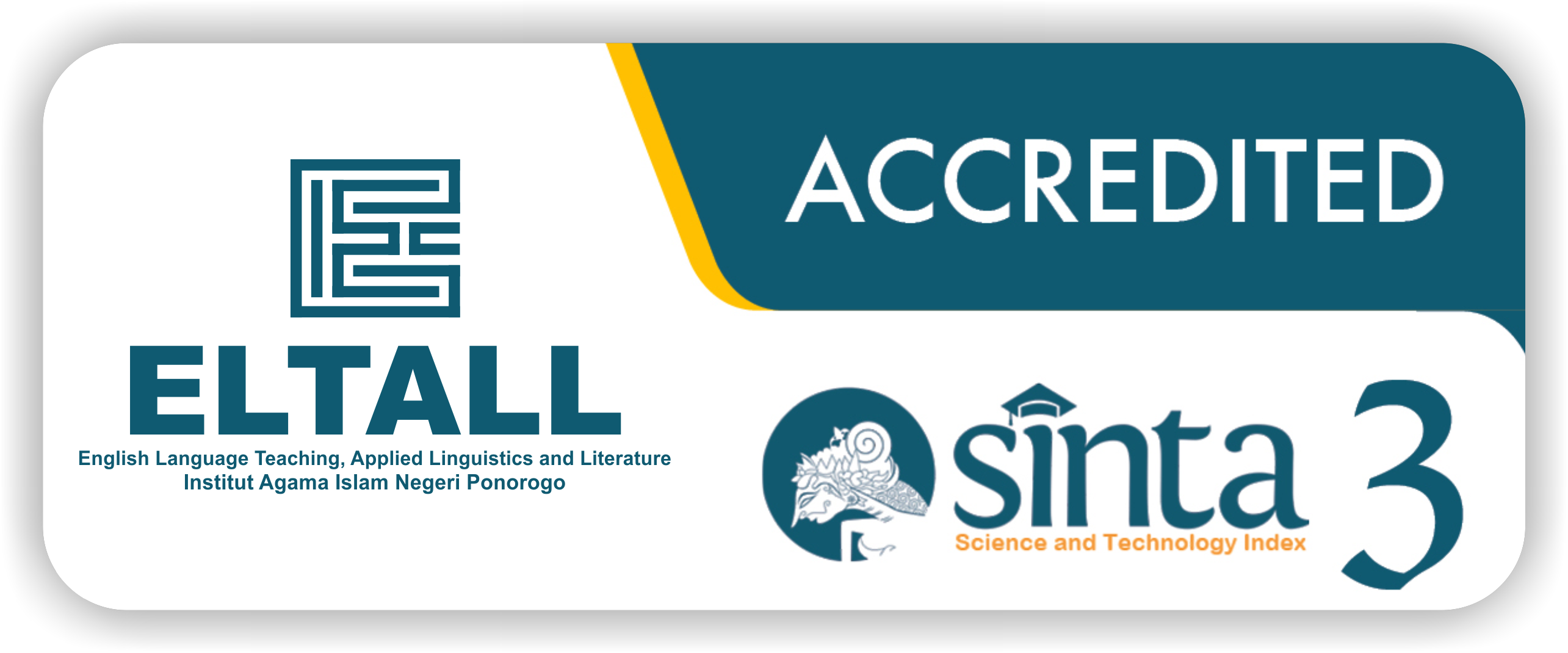Enhancing Students’ Ability in Composing a Well-Developed Paragraph through Social Constructive Learning Facilitated by Peer-Assessment
DOI:
https://doi.org/10.21154/eltall.v5i1.8738Keywords:
paragraph writing, peer and self-assessment, social-constructive learningAbstract
A social constructive learning refers to a context used to build a collaborative learning atmosphere to have in-depth learning by empowering students’ performances and progress cooperatively. It is needed to upgrade students’ proficiency in delivering an idea through a written expression. Therefore, the students can build up their writing ability constructively. This is a descriptive qualitative study that is used to explore a meaningful learning experience in a paragraph writing class using peer-assessment. This research involved 23 students at the second semester of the English department of State Islamic Study of Ponorogo. The data were gathered from a performance test of all the participants, supported by the data derived from interviews, and documentation was also conducted to support the data of the students’ ability in writing. The data were analyzed interactively through (1) data reduction; (2) data display; and (3) conclusion. The results of the study showed that the students were triggered to rearrange their writing confidently because their peers showed their weaknesses and gave suggestions on their mistakes. It boosted the students to write better, so that, the students could produce the expected paragraph writing outcome after they were actively upgrading performances in writing through ongoing learning. Hence, the students were directed to elaborate their writing ability through interactive, constructive, and reflective activities. This paper was aimed at describing the implementation of social constructive learning in a paragraph writing class mediated by the use of peer-assessment. The implication of this study is to promote the students to learn paragraph writing faster since this learning triggered the students have experiences in learning together by checking, sharing, solving, and formulating a solution.
References
Aliki Thomas, Anita Menon, Jill Boruff, Ana Maria Rodriguez and Sara Ahmed.
(2014). Applications of social constructivist learning theories in knowledge
translation for healthcare professionals: a scoping review. Implementation
Science. http://www.implementationscience.com/content/9/1/54
Annisa Raudatus Sa’adah. (2021). Writing Skill in Teaching English: An Overview.
EDUCASIA, Vol. 5 No. 1, 2020, www.educasia
Bambang Sugeng & Ani Wilujeng Suryani. (2020). Enhancing the learning performance of
passive learners in a Financial Management class using Problem-Based LearningFinancial Management class. Journal of University Teaching & Learning
PracticeJournal of UniversityTeaching & Learning. 17(1), 2020. Available
at:https://ro.uow.edu.au/jutlp/vol17/iss1/5.
Basuki and Hariyanto. (2014). Basuki, I., & Hariyanto, H. (2014). Asesmen
pembelajaran. Rosdakarya.
David Boud. (2003). Enhancing Learning Through Self-Assessment.
RoutledgeFalmer, 2 Park Square, Milton Park, Abingdon, Oxon, OX14 4RN
Madison Ave, New York NY 10016: New York.
Khafidatur Rohmah, Endah Tri Priyatni, & Heri Suwignyo. Developing self and peer
assessment to improve student's appreciative critical ability in learning
drama appreciation. Jurnal Penelitian dan Evaluasi Pendidikan Volume 25,
No 1, June 2021 (49-62. http://journal.uny.ac.id/index.php/jpep
Ken, Hyland.(2003).Second Language Writing. Cambridge University Press;
New York.
Fuchs, L. S., & Fuchs, D. (1986). Effects of systematic formative evaluation: A
meta-analysis. Exceptional
Hasan, A. (2022). Effect of Rubric-Based Feedback on the Writing Skills of High
School Graders. Journal of Innovation in Educational and Cultural
Research, 3(1). DOI: 10.46843/jiecr.v3i1.45.
Lantolf, J.P. (Ed.). (2000). Sociocultural theory and second language learning.
Oxford, UK: Oxford University Press.
Lord, T., Travis, S., Magill, B., & King, L. (2005). Comparing student-centered and
teacher-centered instruction in college biology labs. Indiana, PA: Indiana
Ngo Nhat Phuong Quynh. 2021. Using Peer Assessment in Writing for EFL Learners.
Proceedings of the 17th International Conference of the Asia Association of
Computer-Assisted Language Learning (AsiaCALL 2021). Advances in Social
Science, Education and Humanities Research, volume 533
James B Heald, Mete Lengyel, & Daniel M. Wolper. (2023). Contextual inference in
learning and memory. Sciencedirect. Volume 27, Issue 1, January 2023,
-64, https://doi.org/10.1016/j.tics.2022.10.004
Marjan Laal & Seyed Mohammad Ghodsi. (2012). Benefits of collaborative learning
. Procedia - Social and Behavioral Sciences. Volume 31, 2012, Pages 486-
https://doi.org/10.1016/j.sbspro.2011.12.091.
Rajendra Kumar Shah. (2019). Effective Constructivist Teaching Learning in the
Classroom. International Journal of Education, 7(4), 1”“13, E-ISSN:
-1334, DOI: https://doi.org/10.34293/ education.v7i4.600,
Rochmiyati, R. (2013). Model Peer Assessment pada Pembelajaran Kolaboratif
Elaborasi IPS Terpadu di Sekolah Menengah Pertama. Jurnal Penelitian dan
Evaluasi Pendidikan, 17(2), 333”“346.
https://doi.org/10.21831/pep.v17i2.1704Dr Priya Mathew a, Dr Prasanth
Mathew b, Mr. Prince, J. Peechattu. (2017). Reflective Practices: a Means to Teacher
Development. Asia Pacific Journal of Contemporary Education and
Communication Technology (APJCECT).
ISBN: 978 0 9943656 82; ISSN: 2205-6181, 3(1), www.apiar.org.au
Scardamalia, M. & Bereiter, C. (1996) Student communities for the advancement of
knowledge, Communications of the ACM, 39(4), 36”“37
Welly, A., & Murwani, U. (2018). Social Constructivism-Based Reading
Comprehension Teaching Design at Politeknik Negeri Sriwijaya. Arab World
English Journal (AWEJ) Volume 9. Number 1. March 2018 Pp. 447-467
Downloads
Published
Issue
Section
License
Copyright (c) 2024 ELTALL: English Language Teaching, Applied Linguistic and Literature

This work is licensed under a Creative Commons Attribution-NonCommercial 4.0 International License.
All articles published in ELTALL (English Language Teaching, Applied Linguistics, and Literature Journal) are licensed under the Creative Commons Attribution-NonCommercial 4.0 International License (CC BY-NC 4.0).
Under this license, authors and readers are free to:
- Share. copy and redistribute the material in any medium or format
- Adapt. remix, transform, and build upon the material
Under the following terms:
- Attribution. You must give appropriate credit, provide a link to the license, and indicate if changes were made. You may do so in any reasonable manner but not in any way that suggests the licensor endorses you or your use.
- Non-Commercial. You may not use the material for commercial purposes.
Notices:
- The licensor cannot revoke these freedoms as long as you follow the license terms.
- No additional restrictions. You may not apply legal terms or technological measures that legally restrict others from doing anything the license permits.
For the full legal code of the license, please visit: https://creativecommons.org/licenses/by-nc/4.0/













